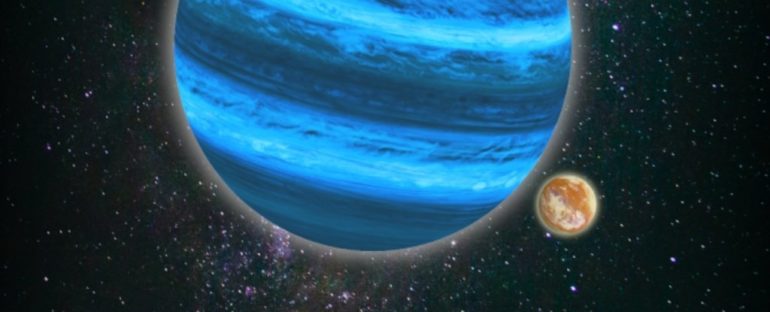It’s hard to tell what’s lurking out there, in the dark voids between the stars.
Evidence, however, suggests the existence of a vast population of rogue exoplanets, set adrift and tethered to no star. Far from the live-giving warmth a star provides, these lonely exoplanets are unlikely to be habitable.
Their moons might be another story.
According to new mathematical modeling, some of those moons – at least, those with very specific conditions – could potentially harbor both atmospheres and liquid water, thanks to a combination of cosmic radiation and the tidal forces exerted on the moon by the gravitational interaction with its planet.
While it’s difficult to catalog exoplanets in general, never mind exoplanets unattached to a star, surveys have identified candidates by studying the gravitational effect these exoplanets should have on distant starlight.
Estimates from these surveys suggest there may be at least one rogue Jupiter-sized gas giant exoplanet for every star in the Milky Way.
If so, that’s at least 100 billion rogue exoplanets – and previous research found that at least some of these rogue exoplanets could have been yeeted out of their home system along with an exomoon. (We’ve not yet conclusively detected an exomoon, but given the preponderance of moons within the Solar System, the existence of exomoons is all but certain.)
Here on Earth, most life relies upon a food web resting on a foundation of photosynthesis – that is, it absolutely requires the light and heat of the Sun. This heat is also what helps keep the water on Earth’s surface liquid – a prerequisite for life as we know it.
Yet, out beyond the Solar System’s frost line, where liquid water is expected to freeze, there are places where it can still be found. These are the ice moons Ganymede and Europa, in orbit around Jupiter, and Enceladus, in Saturnian orbit.
Although encased in thick shells of ice, these moons harbor liquid oceans below their surfaces, thought to be kept from freezing by internal heat generated by the stretching and squeezing exerted by the planets’ gravitational field as the moons orbit.
Thus, it’s thought that Europa and Enceladus might harbor life. Although shielded from sunlight, there is a type of ecosystem here on Earth that doesn’t rely on the photosynthetic food web – the hydrothermal vents, where heat and chemicals escape from Earth’s interior, into the bottom of the ocean.
Around these vents, bacteria that harness energy from chemical reactions thrive; on those bacteria, other organisms can feed, building a whole new food web that doesn’t involve sunlight at all.
So, a team of scientists led by astronomer Patricio Javier Ávila of the University of Concepción in Chile sought to model the possibility of such exomoons existing around rogue gas giant exoplanets.
Specifically, an exoplanet the mass of Jupiter, hosting an exomoon the mass of Earth with an atmosphere that’s 90 percent carbon dioxide and 10 percent hydrogen, over the system’s evolutionary history.
Their findings suggest that a significant amount of water can be formed in the exomoon’s atmosphere, and retained in liquid form.
Cosmic radiation would be the main driver of chemical kinematics to convert hydrogen and carbon dioxide into water. This would produce 10,000 times less water than Earth’s oceans, but 100 times more than the atmosphere – that, the researchers said, would be sufficient for life.
Tidal forces from the exoplanet’s gravity would then generate much of the heat required to keep the water liquid. Even more heat could be contributed by carbon dioxide in the exomoon’s atmosphere, which could create a greenhouse effect to also help keep the world temperate.
“The presence of water on the surface of the exomoon, affected by the capability of the atmosphere to keep a temperature above the melting point, might favor the development of prebiotic chemistry,” the researchers wrote in their paper.
“Under these conditions, if the orbital parameters are stable to guarantee a constant tidal heating, once water is formed, it remains liquid over the entire system evolution, and therefore providing favorable conditions for the emergence of life.”
The research has been published in the International Journal of Astrobiology.



